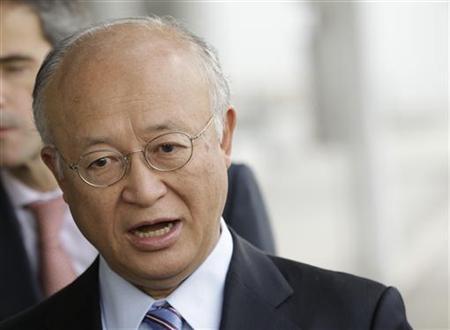(Reuters) – A U.N. watchdog report is expected to show that Iran has installed more uranium enrichment centrifuges at an underground site, potentially boosting the output capacity of nuclear work major powers want it to stop, Western diplomatic sources say.

Two sources said Iran may have placed in position nearly 350 machines since February – in addition to the almost 700 already operating at the Fordow facility for higher-grade enrichment – but that they were not yet being used to refine uranium.
If confirmed in the next quarterly report on Iran’s nuclear programme by the U.N. International Atomic Energy Agency (IAEA), expected on Friday, this is likely to be seen as a sign of continued defiance by the Islamic state of international demands that it suspend such activity.
Getting Tehran to halt its enrichment of uranium to a fissile concentration of 20 percent – which it started two years ago and has since sharply expanded – was a key priority for world powers in their talks with Iran in Baghdad which continued for a second day on Thursday.
Progress in Iran’s nuclear programme is closely watched by the West and Israel as it could determine how much time Iran would need to build nuclear bombs, should it decide to do so. Iran says its programme is entirely peaceful.
Nuclear bombs require uranium enriched to 90 percent, but much of the effort required to get there is already achieved once uranium reaches 20 percent concentration, shortening the time needed for any nuclear weapons “break-out”.
Olli Heinonen, until 2010 head of IAEA safeguards inspections worldwide, said Iran would likely have a stockpile of more than 250 kg of uranium refined to the 20 percent level by the end of this year.
“Iran would be able to turn the stock to highly enriched uranium components of a nuclear weapon in a couple of months time,” Heinonen, now at Harvard University’s Belfer Center for Science and International Affairs, wrote in a paper.
Fordow, buried beneath an estimated 80 meters (265 feet) of rock and soil, gives Iran better protection against any Israeli or U.S. military strikes, and the transfer of nuclear work to the site is of particular concern for the West.
POTENTIAL BOMB MATERIAL
The last IAEA report, published in February, said Iran had trebled output of 20 percent uranium since late 2011 after launching production at Fordow near the Shi’ite Muslim holy city of Qom. The stockpile was estimated at nearly 120 kg.
The new report is not expected to show Iran further increasing the production rate. But the installation of possibly hundreds more centrifuges could set the stage for that in future. Such machines spin at supersonic speed to raise the concentration of the fissile isotope of uranium.
Typically 174 centrifuges are needed for one production unit, but Iran has for its higher-grade enrichment work been using sets of two interconnected cascades, each set containing 348 such machines, to increase efficiency.
It is operating two of those units at Fordow, as well as one at an above-ground site at Natanz in central Iran, and one more may now be nearing completion at Fordow, the sources said.
“Unless the Iranians feed it (with low-enriched uranium) at the last minute, it is installed but not yet fed, so maybe not quite ready yet,” one diplomat said of the new unit.
Iran has suggested it would close down the production of 20 percent enriched uranium at Natanz – where the work started in 2010 – once Fordow was up and running. But Western diplomats believe it has yet to do so.
Iran’s mission to the IAEA, the Vienna-based U.N. agency, was not immediately available for comment.
Iran has steadily increased uranium enrichment since 2007 and now has enough of the 3.5 and 20 percent material for some four bombs if refined further, experts say.
The lower-grade uranium is the usual level required for nuclear power plants. Iran says it is producing 20 percent uranium to make fuel for a medical research reactor.
Tehran denies Western accusations of a nuclear weapons agenda and says it has a sovereign right to peaceful nuclear technology, repeatedly rejecting U.N. resolutions calling for a suspension of all uranium enrichment.
But it has at times appeared more flexible when it comes to the refinement of uranium to 20 percent and experts say that initially getting Iran to stop this work could open a way to ease the deadlock.
(Editing by Tim Pearce)





